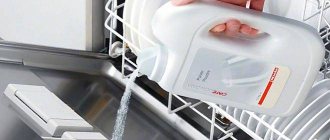3 Aug 2021
14112
Modern consumers often choose refrigerators with an automatic defrosting system No Frost (No Frost), “without frost”. Frost forms in such devices, but it is hidden under a protective casing. They also need to be defrosted for hygienic purposes. The availability of technology itself should not be the determining factor when choosing, but it is important to know its features in order to make an informed decision.
- How does a regular refrigerator work?
- No Frost technology - what is it?
- How No Frost works
- Differences between No Frost, Frost Free and Total No Frost
- Service life of a refrigerator with auto defrost
- Noise level No Frost
- Defrosting No Frost: myth or necessity?
- Other myths about the No Frost system
- What to choose: a regular refrigerator or No Frost
How does a regular refrigerator work?
Before moving on to the description of No Frost, it is useful to understand the general principle of operation of a single-compartment refrigerator. It consists of a compressor, evaporator and condenser, which interact with each other:
- First, the compressor pumps freon (refrigerant) vapor from the evaporator and forces it into the condenser, a system of U-shaped tubes sometimes seen on the back of the refrigerator.
- In the condenser the vapors are cooled and the freon passes into the liquid phase.
- Then the liquid freon flows back into the evaporator through the capillary tube and boils, turning back into steam. At the moment of boiling, freon takes heat from the evaporator, thereby cooling the refrigerator chamber.
- The cycle is repeated until the evaporator temperature reaches the value specified in the settings.
Older two-compartment refrigerators have one evaporator for two chambers: the freezer and the main compartment. New models are equipped with two evaporators; there may also be two motor-compressors, but this design is less common.
Scheme of operation of a single-chamber refrigerator
The disadvantage of the classic or drip cooling system is that it accumulates excess moisture - condensation. It flows down the back wall into a reservoir at the bottom of the refrigerator, but in the process the moisture can freeze and turn into frost, which must be removed manually periodically.
Disadvantages of the drip system
Frost layer:
- Negatively affects the operation of the system. Due to its low thermal conductivity, the snow “cap” disrupts the freezing regime, worsening the heat exchange between the evaporator and the food inside the refrigerator.
- It interferes with getting food out, takes up useful space, and food may stick to the surface of the refrigerator.
- Promotes the formation of bacteria.
- Accumulates unpleasant odors.
Which system is better for a separate freezer?
- Freezers will be an excellent alternative to standard refrigerators. Oversized chests are silent in operation, consume a minimum of electricity, and are equipped with a drip system. But such models take up a lot of usable space.
- Horizontal freezers in the form of cabinets are more ergonomic. They can accommodate fewer products than in chests, but the owner can choose the type of system - drip or No Frost. Also, these models are compact in size and can be easily integrated into a kitchen set.
- Two snowflakes indicate budget models that freeze food to a temperature of -12°C. This is an inexpensive option for storing vegetables and fruits, but is not suitable for freezing meat and fish dishes.
- It is more rational to focus on more expensive branded models, indicated by three snowflakes. The deep freeze mode allows you to quickly freeze products within the range from -18 to -24°C.
- If a blast freezing mode is required, this model can be easily recognized by its marking with four snowflakes.
- The best freezers, according to consumers, are the practical and affordable lines of the brands Atlant, Pozis, Liebherr, Indesit, Vestfrost and Gorenje. Their cost ranges from 10 to 20 thousand rubles.
- Household freezing units are capable of freezing a certain amount of food - usually 5-15 kg per day. The power of industrial freezers allows you to freeze up to 40 kg of food.
If you need to quickly freeze food or store large volumes, it is better to choose a system with No Frost. If you need to freeze warm foods, choose options with Super Frost modes.
If the freezer is used to store food and dishes for a long time, it is better to choose a unit with a drip system. It is cheaper and consumes little electricity. In the event of a breakdown, repairing such a freezer will cost less.
No Frost technology - what is it?
The terms No Frost, Frost Free and Total No Frost hide the technology of automatic defrosting of the evaporator. The principle of cooling operation is changing. The following are added to the design:
- Fans - distribute dry cold air among the compartments (technically, drip refrigerators can also have fans - again for air distribution, but in the No Frost system they are indispensable). The design also includes a system of air channels through which the flow is directed to the refrigerated products.
- Heater (or heating element) - heats the evaporator coil to remove frost on it. Heating duration is 15–30 minutes every 6–24 hours (depending on the model and manufacturer).
Timer - responsible for heating cycles. In early models it could work continuously, in new ones - only while the compressor was running. This saves significant energy compared to technology pioneers.
Useful video
On the Internet you can read advice from “experienced” people who talk about quick ways to defrost a refrigerator using a hot hairdryer or a cup of hot water. I categorically do not advise doing this: you risk damaging complex equipment. From my own experience I can say: these tips are not needed in principle. No frost eliminates the ice build-up that our mothers and grandmothers used to beat off with a hammer in their ancient freezers.
Advice. Use a soft-bristled brush to clean hard-to-reach areas, and clean the ventilation holes with cotton swabs.
How No Frost works
When the coil is heated, the frost melts, the resulting liquid is supplied to a container on the surface of the compressor and evaporates upon contact with it. The fans stop working to prevent heated air from reaching the food.
To prevent overheating, the system has a thermostat that opens the heater circuit when the evaporator reaches a certain temperature (about 5 ℃). The timer is designed so that either the heater or the compressor can operate at the same time.
Alternatively, some systems (usually commercial systems such as ice cream refrigerators) use hot gas to defrost the evaporator, which quickly heats and defrosts it.
Diagram of operation of a refrigerator with the No Frost system
To say that there is no frost in No Frost refrigerators is not entirely true. There is frost, but it is not visible - the structure of the evaporator, heater, compressor and condenser is hidden from view by a protective screen. This serves both aesthetic and safety purposes (increases the life of the device). Does not affect the cost of repairs.
No Frost or drip refrigerator, which is better?
Both defrosting systems, drip and No Frost, compete on equal terms. It is impossible to determine which is better. Much depends on the climate - dry or humid indoor air. A combined method is considered optimal - Free No Frost, when the refrigerator has drip defrosting and the freezer has Low or dry sublimation. In this case, the best options of both systems are used. What is the difference between drip defrosting in the refrigerator and No Frost? The absence of a fan leads to greater usable volume, reduced noise and energy consumption. The drip system is easier to operate than No Frost, the refrigerator is cheaper, which is better for a large group of the population.
However, all premium refrigerators are equipped with inverter compressors and the Fullfrost system. This means that this is a more progressive way to remove condensate.
Differences between No Frost, Frost Free and Total No Frost
Frost Free is a budget version of the technology. Automatic defrosting occurs only in the freezer compartment; the main one works on the principle of a “crying” evaporator. There is no need to defrost it to remove the “cap”; it does not have time to form. Frost in the refrigerator compartment melts naturally while the compressor rests. The maximum that the user will see is drops of moisture on the back wall of the device. They can be removed with a dry cloth.
No Frost (or Full No Frost) - the classic version, in which cold air blows through both chambers: low and medium temperature. In designs with one evaporator, the main air flow enters the freezer, and the residual air flows into the refrigerator compartment through a system of channels. If the system has two evaporators and two fans (one for each chamber), the flow is distributed evenly.
Total No Frost is usually the same as Full No Frost, but with additional air purifying features that help fight odors and bacteria.
For example, Haier antibacterial devices include:
- Fresh Turbo UV lamp, which creates UVC radiation (we wrote in detail about how this works in Haier washing machines; there is a similar technology here).
- T.ABT antibacterial treatment technology for air ionization. The module operates on the basis of tourmaline crystals, which, during heating and cooling cycles, generate an electrical charge (positive and negative at different ends of the crystal).
HCS respiratory membrane. Maintains optimal humidity in the fruit and vegetable compartment and keeps them fresh longer. When the humidity in the compartment exceeds 90%, the membrane removes excess water; when humidity, on the contrary, drops, the membrane releases part of the accumulated moisture.
An example of additional functions that Total No Frost implies
What you can fix yourself
Refrigerator won't turn off
If you notice that the device works without interruptions, and the hum has become more distinct, then the reason lies in the operation of the compressor and the wear of its components. First, check some details:
- refrigerator door. The tightness of its closure affects the penetration of warm air, and as a result, the operation of the motor.
- setting modes. Super freezing will not turn off on its own unless you change the position of the regulator.
- Device location. If there is a radiator or a wall next to the refrigerator, the compressor will work worse.
If none of the above helped resolve the problem, then the thermostat or temperature sensor may be broken. Such problems lead to failures in the electronic board, and cooling occurs without interruption. A burnt-out module, a malfunction in the evaporator, a freon gas leak—the service center will help you determine the exact cause of the breakdown. It may be unsafe to fix such problems on your own.
Fan problems
A refrigerator structure without a fan is not possible. The typical problem with this part is that it either works a lot or doesn't work at all.
A stop in fan operation may be due to freezing of its blades. If this really happens, then you should defrost the refrigerator and the problem will disappear. A clogged drain hole or refrigerant leak may cause the fan to not operate. The unit must be defrosted for at least 10 hours. If such measures do not give a positive result, then make sure that the motor is in good condition.
When the blades spin without stopping, this is due to the operation of the evaporator, which is covered with ice. Poor air circulation leads to a decrease in temperature in the refrigerator compartment. Also, uninterrupted operation of the fan may be associated with malfunctions of the compressor, control module and board, which receives erroneous temperature data. If you encounter any of this, then contact service centers for a complete diagnosis of the device.
Service life of a refrigerator with auto defrost
The indicator is individual: it depends on operating conditions, design complexity and other factors. For example, due to the simplicity of their design, Soviet devices still work, even if they do not cool as efficiently as when they were released. If you rely on manufacturers' data, the average service life varies from 7 to 10 years (units, including Haier, indicate 15 years for their models).
According to the National Association of Home Builders (NAHB), the average lifespan of a two-compartment refrigerator is 13 years. Slightly less than gas stoves (15 years), but more than dishwashers and washing machines (10 years). At the same time, the obsolescence of equipment occurs faster - after 4–5 years.
For No Frost refrigerators, the figure may be slightly higher due to the closed design and regular defrosting of the evaporator, but there is no fundamental difference compared to a conventional refrigerator.
Do not confuse the service life with the warranty period. The manufacturer indicates both the first and second in the technical data sheet of the device. All Haier refrigerators, when purchased from official sales departments and online stores, have an extended warranty of 5 years. The warranty separately for the inverter compressor can reach 12 years
The operating conditions are partially determined by the climate class of the refrigerator (the manufacturer prescribes it in the technical passport). It comes in four types: SN - for temperate climate (10-32 ℃), ST - for subtropical (18-38 ℃), N - normal (16-32 ℃) and T - tropical (18-43 ℃). If you use your refrigerator outside of its suitable temperatures, the compressor may be damaged.
Noise level No Frost
The data that such refrigerators are louder than regular ones is a myth. The volume depends on the characteristics of the engine (motor-compressor); the type of cooling does not affect the noise. Let's compare four devices.
Two Haier refrigerators with an inverter and a standard compressor (both with the No Frost system), the legendary Soviet refrigerator “Moscow”, which was produced by the Plant named after. Likhachev in the 50s and 60s, as well as a model of the Haier refrigerator, discontinued - its analogues are still found both in household appliance stores and in people's kitchens.
The result of the comparison (see results in the table): Haier refrigerators with the No Frost system work almost the same as devices with drip cooling.
Comparison of noise level of drip refrigerators and No Frost
The energy consumption of refrigerators is indicated in kilowatt-hours per year (kWh/g), not to be confused with kilowatts. This is a non-systemic unit, the use of which is regulated by the revised Soviet GOST 8.417. It shows the average energy consumption per year - that is, over a year of operation, the refrigerator will generate, for example, 268 kWh. Or, if recalculated, 31 W per hour, 0.73 kW per day and 22.3 kW per month.
Organization of air movement
The circulation of air flows is responsible for the uniform distribution of cold inside the unit. Modern devices use different movement systems:
- Super-X-Flow - a screw fan creates vortex flows;
- Air Shower - air moves vertically, allowing food and drinks to cool much faster;
- Multi Flow - multi-level air supply stabilizes the temperature inside the chambers. It involves a combination of “no frost” and drip cooling techniques.
Defrosting No Frost: myth or necessity?
According to Microban, which provides technology solutions for antimicrobial safety, 15% of refrigerators in Philadelphia contain harmful bacteria that can cause eating disorders. Another Microban study looked at Frost Free refrigerators and found that the vegetable compartments contained an average of 7,850 colony-forming units (CFU) of bacteria per square centimeter.
Therefore, in the context of No Frost, we are not talking about defrosting in the classical sense, but about preventive shutdown. The goal is hygienic. A number of manufacturers also write that regular defrosting (1-2 times a year) helps extend the life of the refrigerator. At the same time, there are cases when devices with automatic defrosting worked for 10 years without shutting down (data from RemBytTech).
How to prevent No Frost
- Unplug the refrigerator.
- Take out groceries, empty shelves and drawers.
- Treat surfaces with an antiseptic containing 60–70% alcohol or a cleaning agent without aggressive chemicals. A simpler option is soda or a mixture of soda and vinegar (sodium bicarbonate and acetic acid have an antiseptic effect, but do not act on all bacteria; they will not provide 100% disinfection).
- Wait 10–15 minutes. Waiting times of 1 hour or more are also a myth. It is explained by the fact that after the motor is turned off, the refrigerant in the condenser is under pressure. If you do not wait until the pressure normalizes, the motor will not be able to move the piston and the compressor will jam. But modern refrigerator models are equipped with a protective relay that will prevent the device’s motor from starting if this threatens the operation of the compressor.
- After a pause of 10–15 minutes, you can connect the refrigerator to the network and return the food to its place.
Manufacturers do not recommend defrosting the refrigerator in hot weather to avoid temperature differences inside and outside the refrigerator compartment - this can affect the compressor. When defrosting in summer, it is better to choose the evening when the heat subsides.
Advantages and disadvantages
The main advantages of No Frost refrigerators are:
- defrosting does not take much time and is carried out once every six months no more often. The rest of the time the device does everything itself;
- complete cooling of the device, regardless of the location of the shelves;
- repairs at home become simple;
- rapid restoration of temperature conditions;
- cleansing takes less time and effort;
- metal grilles are a thing of the past; they have been replaced by transparent plastic shelves;
- The evaporator is reliably protected from damage.
Users highlight some disadvantages in such models:
- windy freezing dries out food. If you cover the food with cling film, the problem disappears;
- Noisy operation of the refrigerator. In modern models you will rarely hear a hum that alternates with periods of calm;
- large waste of electricity;
- high price.
Other myths about the No Frost system
- The No Frost system protects against unpleasant odors by 100%. This is not entirely fair - odors can still occur if food spoils. But due to constant air circulation, they will erode faster, the likelihood of their occurrence will also be lower (many studies have been devoted to the benefits of ventilation, and circulation is the same; one of them says that bacterial colonies are reduced by 50%).
- Due to heating and cooling cycles, the temperature fluctuates, which means that a device with the No Frost function needs to spend more energy to maintain the evaporator temperature. The myth, firstly, is refuted by the fact that modern condensers and evaporators work more efficiently than those created 10 or more years ago. Secondly, the accumulation of a “coat of snow” in refrigerators with a drip system leads to the fact that the thermal insulation suffers; the compressor needs more time to cool the chamber. Therefore, theoretically, a “crying” refrigerator can consume even more energy (especially if it is an old model - “fur coat” is also rare in new ones).
- A consequence of the previous myth is that refrigerators with auto-defrost are noisier. The comparison table above refutes this fact. The noise level depends rather on the type of motor (inverter or standard), its transmission (belt or direct drive) and other design features.
- You can put hot foods in a refrigerator with a No Frost system. Not always - to cope with steam, the refrigerator must at least have a special internal coating designed to withstand a sharp increase in temperature. The general recommendation is to place food at room temperature, unless the manufacturer's instructions indicate otherwise.
- The No Frost function is harmful to health. This myth has no evidence base. The closest research is that dry warm air is a comfortable environment for viruses, but dry cold air, on the contrary, will prevent food in the refrigerator from becoming slimy, and its even distribution will remove unpleasant odors.
- There are no big No Frost models. The myth is refuted by the Haier line of two-chamber and three-chamber refrigerators. Separately, we note built-in devices with a refrigerator volume of up to 248 liters.
Examples of No Frost refrigerators
Most common faults
Modern models with two cameras are equipped with electronic control, and therefore belong to the class of vulnerable equipment. Typical problems are:
- damage to the electrical panel;
- the compressor runs without stopping;
- accumulation of water in the refrigerator;
- different performance indicators of the freezer and refrigeration chambers;
- excessive noise and hum from the device.
Such malfunctions are associated with system parts and electronic components, so to eliminate them you need to contact specialists. Other problems are rare, but are often found in two-chamber Samsung No Frost refrigerators. Broken heating element circuit, leak of freon fluid, defective fan in the evaporator blower, etc.
Problems with the unit arise due to violations of operating conditions, that is, through the fault of the user himself. Malfunctions such as adjusting doors, their overweight, replacing the power cord, or clogged drains can be fixed independently, without the help of a technician. Next, we will look at what can be done at home to optimize the operation of the No Frost refrigerator.











